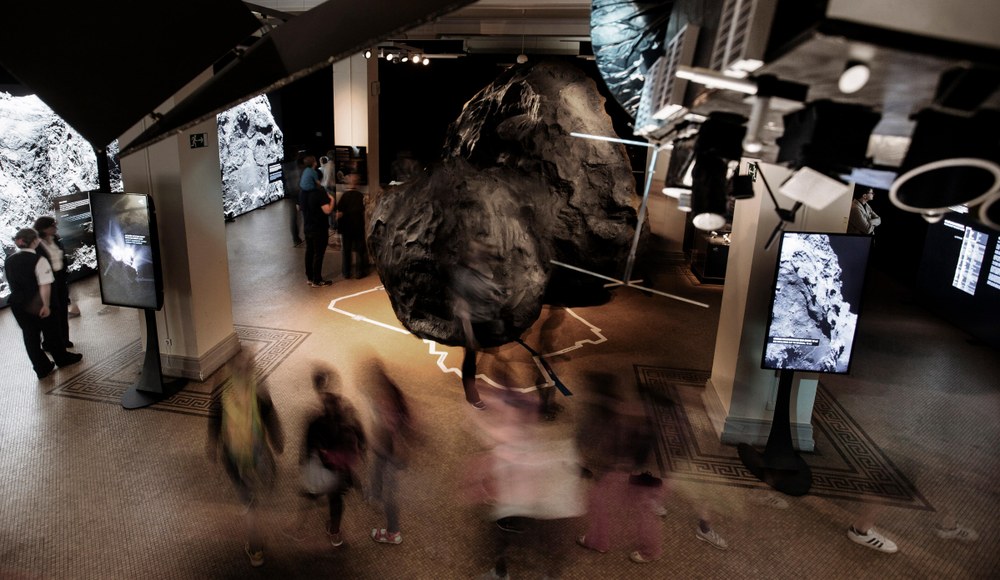More than 700,000 visitors at the 'COMETS' exhibition



The special exhibition 'COMETS – The Rosetta mission: A journey to the origins of the Solar System' has been the main attraction at the Museum für Naturkunde in Berlin for the last six months. Conceived and prepared by the German Aerospace Center (Deutsches Zentrum für Luft- und Raumfahrt; DLR) in cooperation with the world-famous Berlin museum and the Max Planck Society, the exhibition ended on 26 January 2017. The museum estimated a total of 700,000 visitors, who not only learned about comets and the European Rosetta mission, but had the opportunity to stand before the four-metre large 1:1000 scale model Comet 67P/Churyumov-Gerasimenko. The Rosetta spacecraft and the lander Philae were launched in 2004. After a long, 10-year journey travelling billions of kilometres, they arrived at their destination. Between 2014 and 2016, the Rosetta spacecraft explored the mysterious 'hairy star' from orbit and the Philae lander, deposited on the comet by Rosetta, investigated the comet directly from the surface.
In an exhibition space of approximately 800 square meters, visitors were not only presented with faithful models of the target comet, the Rosetta spacecraft, the Rosetta Stone and the Philae lander, but also with a wealth of information about the objectives and progress of the mission. The exhibition also provided information on the role of comets in the development of the Solar System. Comets, as well as the 'predictable' planets, were considered enigmatic objects – at least until the invention of the telescope – and were accordingly laden with mythological interpretations. It was not until the beginning of space flight, some 60 years ago, that scientists finally had the tool to decipher these enigmatic bodies – space probes.
The exhibition told the history of comet research from Plato through to the ESA pioneer probe Giotto, which was launched towards Halley's comet in 1986. This first encounter was the motivation behind the much more complex Rosetta mission. The exhibition provided extensive explanations of the scientific results of the Rosetta mission. Comets were witnesses of the formation of planets four and a half billion years ago; therefore, their exploration is vital for understanding the early Solar System.
"Rosetta's observations of 67P over a long period of time and at close range contributed significantly to gaining a clearer picture of the processes leading to the formation of planets," explains Tilman Spohn from the To the Institute's website. "We now have a better understanding of how comets 'work', how their atmosphere, coma and their characteristic tail form. In addition, we have learned that they are made up of much more dust than ice, are highly porous, and also carry complex hydrocarbon compounds." One surprising discovery of the mission was that the water in Earth's oceans does not come from the ice of comets like 67P/Churyumov-Gerasimenko. "These and many other results are displayed and explained in the exhibition," explains Spohn.
Several nine-square-metre back-lit displays gave visitors a close-up view of 67P, bringing them face-to-face with the variety of its rugged landscape. The highlight of the mission was the landing of Philae on the comet's surface, which is depicted in detail at several stations and reproduced using models. "In the exhibition, we also wanted to demonstrate that such a project could not be possible without the cooperation of hundreds of scientists, engineers, technicians and planners – in other words, people who are inspired by an idea," says Ekkehard Kührt, planetary researcher at DLR and responsible for DLR's scientific contribution to the Rosetta and Philae mission. "Perhaps this 'spark of inspiration', which has kept us going for three decades on Rosetta, has also rubbed off on some of the visitors."
Scientists from the DLR Institute of Planetary research were responsible for the design and content of the 'COMETS' exhibition. It is now being set up as a travelling exhibition that will be showcased in other large natural science museums in German-speaking countries, as well as other countries, including the United States.
